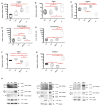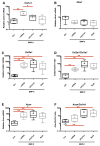RNA Interference and BMP-2 Stimulation Allows Equine Chondrocytes Redifferentiation in 3D-Hypoxia Cell Culture Model: Application for Matrix-Induced Autologous Chondrocyte Implantation
- PMID: 28837082
- PMCID: PMC5618491
- DOI: 10.3390/ijms18091842
RNA Interference and BMP-2 Stimulation Allows Equine Chondrocytes Redifferentiation in 3D-Hypoxia Cell Culture Model: Application for Matrix-Induced Autologous Chondrocyte Implantation
Abstract
As in humans, osteoarthritis (OA) causes considerable economic loss to the equine industry. New hopes for cartilage repair have emerged with the matrix-associated autologous chondrocyte implantation (MACI). Nevertheless, its limitation is due to the dedifferentiation occurring during the chondrocyte amplification phase, leading to the loss of its capacity to produce a hyaline extracellular matrix (ECM). To enhance the MACI therapy efficiency, we have developed a strategy for chondrocyte redifferentiation, and demonstrated its feasibility in the equine model. Thus, to mimic the cartilage microenvironment, the equine dedifferentiated chondrocytes were cultured in type I/III collagen sponges for 7 days under hypoxia in the presence of BMP-2. In addition, chondrocytes were transfected by siRNA targeting Col1a1 and Htra1 mRNAs, which are overexpressed during dedifferentiation and OA. To investigate the quality of the neo-synthesized ECM, specific and atypical cartilage markers were evaluated by RT-qPCR and Western blot. Our results show that the combination of 3D hypoxia cell culture, BMP-2 (Bone morphogenetic protein-2), and RNA interference, increases the chondrocytes functional indexes (Col2a1/Col1a1, Acan/Col1a1), leading to an effective chondrocyte redifferentiation. These data represent a proof of concept for this process of application, in vitro, in the equine model, and will lead to the improvement of the MACI efficiency for cartilage tissue engineering therapy in preclinical/clinical trials, both in equine and human medicine.
Keywords: BMP-2; Col1a1; HtrA1; chondrocyte; dedifferentiation; equine model; hypoxia; matrix-associated autologous chondrocyte implantation (MACI); siRNA; tissue engineering; type II collagen.
Conflict of interest statement
The authors declare no conflict of interest.
Figures










Similar articles
-
Improvement of the Chondrocyte-Specific Phenotype upon Equine Bone Marrow Mesenchymal Stem Cell Differentiation: Influence of Culture Time, Transforming Growth Factors and Type I Collagen siRNAs on the Differentiation Index.Int J Mol Sci. 2018 Feb 1;19(2):435. doi: 10.3390/ijms19020435. Int J Mol Sci. 2018. PMID: 29389887 Free PMC article.
-
Characterization and use of Equine Bone Marrow Mesenchymal Stem Cells in Equine Cartilage Engineering. Study of their Hyaline Cartilage Forming Potential when Cultured under Hypoxia within a Biomaterial in the Presence of BMP-2 and TGF-ß1.Stem Cell Rev Rep. 2017 Oct;13(5):611-630. doi: 10.1007/s12015-017-9748-y. Stem Cell Rev Rep. 2017. PMID: 28597211
-
Enhanced hyaline cartilage matrix synthesis in collagen sponge scaffolds by using siRNA to stabilize chondrocytes phenotype cultured with bone morphogenetic protein-2 under hypoxia.Tissue Eng Part C Methods. 2013 Jul;19(7):550-67. doi: 10.1089/ten.TEC.2012.0508. Epub 2013 Feb 19. Tissue Eng Part C Methods. 2013. PMID: 23270543
-
Modulation of collagen synthesis in normal and osteoarthritic cartilage.Biorheology. 2004;41(3-4):535-42. Biorheology. 2004. PMID: 15299284 Review.
-
Cartilage tissue engineering: molecular control of chondrocyte differentiation for proper cartilage matrix reconstruction.Biochim Biophys Acta. 2014 Aug;1840(8):2414-40. doi: 10.1016/j.bbagen.2014.02.030. Epub 2014 Mar 6. Biochim Biophys Acta. 2014. PMID: 24608030 Review.
Cited by
-
Application of Alginate Hydrogels for Next-Generation Articular Cartilage Regeneration.Int J Mol Sci. 2022 Jan 20;23(3):1147. doi: 10.3390/ijms23031147. Int J Mol Sci. 2022. PMID: 35163071 Free PMC article. Review.
-
Redifferentiation of genetically modified dedifferentiated chondrocytes in a microcavitary hydrogel.Biotechnol Lett. 2024 Jun;46(3):483-495. doi: 10.1007/s10529-024-03475-2. Epub 2024 Mar 25. Biotechnol Lett. 2024. PMID: 38523201
-
Differences in the intrinsic chondrogenic potential of equine umbilical cord matrix and cord blood mesenchymal stromal/stem cells for cartilage regeneration.Sci Rep. 2018 Sep 14;8(1):13799. doi: 10.1038/s41598-018-28164-9. Sci Rep. 2018. PMID: 30217993 Free PMC article.
-
High-Resolution Dissection of Chemical Reprogramming from Mouse Embryonic Fibroblasts into Fibrocartilaginous Cells.Stem Cell Reports. 2020 Mar 10;14(3):478-492. doi: 10.1016/j.stemcr.2020.01.013. Epub 2020 Feb 20. Stem Cell Reports. 2020. PMID: 32084387 Free PMC article.
-
Small Molecule Epigenetic Modulators in Pure Chemical Cell Fate Conversion.Stem Cells Int. 2020 Oct 20;2020:8890917. doi: 10.1155/2020/8890917. eCollection 2020. Stem Cells Int. 2020. PMID: 33144865 Free PMC article. Review.
References
-
- Oke S.L., McIlwraith C.W. Review of the economic impact of osteoarthritis and oral joint-health supplements in horses; Proceedings of the 56th Annual Convention of the American Association of Equine Practitioners; Baltimore, MD, USA. 4–8 December 2010; pp. 12–16.
MeSH terms
Substances
LinkOut - more resources
Full Text Sources
Other Literature Sources
Research Materials
Miscellaneous

